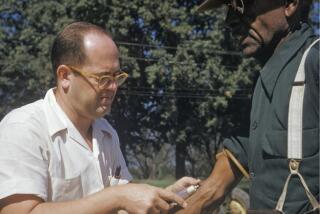Racial Myths Reinforce White Fears : Crime: The President, calling on blacks’ ‘understanding,’ should know the facts.
- Share via
In his speech on race relations last week, President Clinton asked blacks to understand white fears about crime, drugs and welfare. That’s asking a lot, especially when those fears are based on time-worn myths and stereotypes. Unfortunately, instead of dispelling them, Clinton repeated the worst of them.
“Violence for white people too often comes with a black face.”
Two men are facing trial in the bombing of the Oklahoma City federal building last April, the worst mass-murder in U.S. history. Their faces are white, not black.
Many whites have nightmares about being attacked by blacks, but their waking reality is that their attacker will be white. In 1990, according to the FBI, 70% of violent crimes against whites were committed by other whites. In 1991, white males comprised 70% of the juveniles arrested for criminal offenses.
The richer, older and whiter a person, the less chance that person has of being a crime victim. Older white women were the least victimized of any group. Money magazine reports that whites in the $50,000-plus income group were two to three times less likely to be crime victims than the general population. For whites aged 50 to 64, the victim rate dropped 35%.
Whites are marginally at greater risk of being robbed by blacks. It has less to do with their color than their numbers and location. There are seven times more whites than blacks in America. Most robbery of whites happens on urban streets, not at home.
Clinton hinted that the media may have much to do with whites thinking that young black males commit most of the violent crime in America. He’s right. TV cop shows that show mostly young black males being handcuffed, spread-eagled on streets and hauled away to jail reinforce the perception. The relentless entertainment media typecasting of young black males as “gangstas” has made even more whites (and some blacks) fearful of them. Police saturation of black neighborhoods, gang sweeps, drug raids and racially tainted “zero tolerance” stop-and-search policies also add to white fears.
When blacks do commit violent crime, whites are seldom the victims. In 1994, the FBI reports, blacks committed nearly half of the murders and robberies in America; 94% of their victims were other blacks. Blacks were mostly a menace not to society but to themselves.
“It isn’t racist for whites to say they don’t understand why people put up with . . . drugs being sold in the schools or in the open.”
The 1991 National Household Survey on Drug Abuse by the University of Michigan revealed that 8.7 million whites used drugs in a given month versus 1.6 million blacks. And white high school seniors were far more likely to use drugs than black high school seniors.
During the past decade, drug-related arrests accounted for the sharp rise in America’s jail and prison population. A disturbing share of these arrests are a tragic game of numbers that police and politicians play to calm a jittery public that demands the hardest line on crime. Former Reagan drug czar William Bennett laid it on the cost-effective line: “It’s easier and less expensive to arrest black drug users and dealers than whites.” Congress facilitated that approach by lengthening the minimum sentence for crack, widely believed to be the black drug of choice.
It’s true that blacks are disproportionately more involved in crack dealing and are arrested more often. But many whites are also deeply involved in the crack trade, and those who are arrested have more serious criminal histories than blacks. Yet, on average, black crack traffickers receive longer sentences because they are prosecuted under federal law. White dealers in powdered cocaine are more likely to be tried in state court and receive lighter sentences.
“It’s not racist for whites to assert that the culture of welfare dependency . . . cannot be broken . . . unless there is first more personal responsibility.”
Nationally, nearly two out of three welfare recipients are white. The figure for blacks in California, in 1990, was 15.9%. More than 80% of 1,200 black welfare recipients in a 1987 University of Chicago survey said that if jobs were available, they’d take them even if the pay and medical coverage were the same as that provided by welfare.
Clinton wants badly to heal the racial divide. We all should. But blaming and scapegoating blacks for America’s social problems will only deepen that divide.
More to Read
Sign up for Essential California
The most important California stories and recommendations in your inbox every morning.
You may occasionally receive promotional content from the Los Angeles Times.













